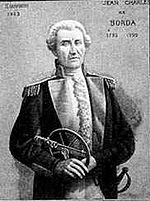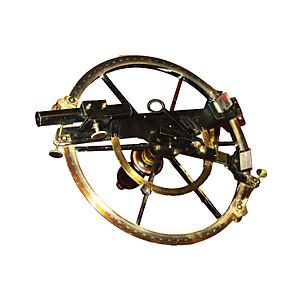Jean-Charles de Borda facts for kids
Quick facts for kids
Jean-Charles de Borda
|
|
|---|---|

Jean-Charles de Borda
|
|
| Born | 4 May 1733 |
| Died | 19 February 1799 (aged 65) |
| Nationality | French |
| Scientific career | |
| Fields | Mathematics |
| Signature | |
 |
|
Jean-Charles de Borda (born May 4, 1733 – died February 19, 1799) was a smart French scientist. He was a mathematician (someone who studies numbers and shapes), a physicist (someone who studies how the world works), and an officer in the French Navy.
About Jean-Charles de Borda
Jean-Charles de Borda was born in a city called Dax. His parents were Jean-Antoine de Borda and Jeanne-Marie Thérèse de Lacroix.
Early Work and Recognition
In 1756, Borda wrote an important paper about how objects move when they are thrown. This was part of his job as a military engineer. Because of this work, he was chosen to join the French Academy of Sciences in 1764. This was a big honor for scientists back then.
Adventures at Sea
Borda was both a sailor and a scientist. He spent time in the Caribbean Sea. There, he tested new and improved chronometers. These were special clocks used to find a ship's exact location at sea.
From 1777 to 1778, he took part in the American Revolutionary War. In 1781, he was put in charge of several ships in the French Navy. The next year, in 1782, the English captured him. But he was soon sent back to France.
After returning, Borda worked as an engineer for the French Navy again. He made better designs for waterwheels and pumps. In 1784, he became France's Inspector of Naval Shipbuilding.
With help from a ship designer named Jacques-Noël Sané, Borda started a huge plan in 1786. They wanted to build many new ships to make the French Navy strong again. These new ships were all based on Sané's standard designs.
The Borda Count Voting System
In 1770, Borda created a special way of voting called the Borda count. This system lets people rank their choices instead of just picking one. For example, you could vote for your favorite, then your second favorite, and so on.
The French Academy of Sciences used Borda's method to choose its new members for about 20 years. But then, Napoleon Bonaparte stopped it. Napoleon wanted his own voting method to be used after he became president of the Academy in 1801.
Today, the Borda count is still used in some schools, competitions, and even in some political elections. It has also helped create other voting methods.
Helping Sailors Find Their Way
In 1778, Borda published a method to figure out a ship's longitude (its east-west position). This was done by measuring the distance between the Moon and other stars. This method was considered the best way to navigate before accurate clocks (chronometers) were widely available.
For example, the famous explorers Lewis and Clark used Borda's method. They used it to find their latitude and longitude during their journey across the northwestern United States.
Creating the Metric System's Meter
Borda also helped create the standard metre. This is the basic unit of length in the metric system. The length of the meter was based on careful measurements of the Earth's size.
Better Measuring Tools
Borda was also very good at making scientific tools. He improved a tool called the reflecting circle. He also improved the repeating circle with his assistant, Etienne Lenoir. This repeating circle was used to measure a long line on Earth from Dunkirk to Barcelona. These measurements helped define the length of the meter.
New Ways to Measure Angles
After the French Revolution, people decided to change how angles were measured. Instead of dividing a quarter circle into 90 degrees, they wanted to divide it into 100 new units called gradians. Each gradian would then be divided into 100 smaller parts.
New Tables and Instruments
This new way of measuring angles meant that new math tables were needed. These tables would help people use the new units for angles. Borda created special tools to measure angles in these new units.
These tools were later used to measure the distance between Dunkirk and Barcelona. This measurement helped scientists figure out the size of the Earth. Knowing the Earth's size was important to officially define the length of the meter.
Borda was very excited about the metric system. He started making tables of logarithms (special math tables) in 1792. These tables were for the new angle units. They were finally published in 1801, after he had passed away. These tables were very detailed, showing numbers with up to ten decimal places.
Changes to Time and Maps
Along with new angle measurements, there was also an idea to divide the day into 10 hours. Each hour would have 100 minutes. Maps also needed to show the new degrees of latitude and longitude.
Even though the new calendar (the Republican Calendar) was stopped by Napoleon in 1806, the 400-unit circle (using gradians) continued to be used.
Honors and Legacy
Many things have been named in honor of Jean-Charles de Borda:
- Five French ships were named Borda.
- A crater on the Moon is called Borda.
- An asteroid (a small space rock) is named 175726 Borda.
- His name is one of the 72 names written on the Eiffel Tower in Paris.
- Cape Borda in South Australia is named after him.
- Île Borda was the name given to Kangaroo Island by explorer Nicholas Baudin.
- The Borda count electoral method is named after him.
- Borda Rock in Antarctica is named after Jean-Charles de Borda.
See also
 In Spanish: Jean-Charles de Borda para niños
In Spanish: Jean-Charles de Borda para niños
- Borda–Carnot equation
- Carlos Ibáñez e Ibáñez de Ibero – 1st president of the International Committee for Weights and Measures and president of the International Geodetic Association


